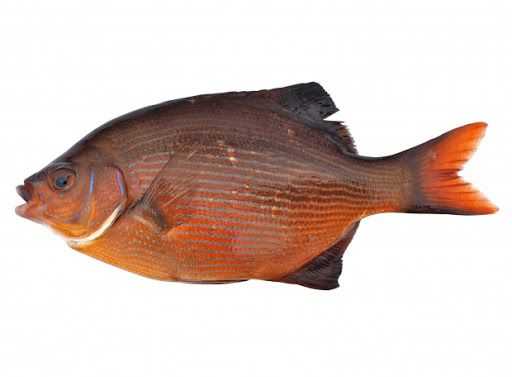Striped Seaperch

Species Details
Embiotoca Lateralis
Embiotocidae
Perciformes
Reefs, Nearshore, Backcountry
1 - 2 lbs.
9" - 15"
Striped Seaperch (Embiotica lateralis) Fish Description
Also known as Striped Surfperch, the Striped Seaperch hails from the North Eastern Pacific Ocean. It is a member of the Embiotocidae or Surfperch family.
The Striped Seaperch has blue spots and stripes on its head and operculum. Still, it is sometimes confused with the Rainbow Seaperch.
The body of the Striped Seaperch is covered in scales, oval in shape, and deeply compressed. Its body and fins have the color of copper. It also possesses dark blotches on the pelvic fins, the soft dorsal fin, the base of the caudal fin, and the anal fin. Compared to other perches, the Striped Seaperch has a bigger mouth which extends up to the ends of its eyes.
The Striped Seaperch has 22 to 27 gill rakers; its lateral line is arched. Its dorsal fin contains 11 spines, and 23 to 25 rays. Its caudal fin is short and has a deep base. Its anal fins has 3 spines, and 29 to 33 rays.
Diet and Size
The Striped Seaperch are diurnal feeders (meaning, they feed during the day). With their large mouths, they feast on polychaete worms, shrimps, mussels, isopods, gastropods, and brittle stars. Young Striped Seaperch fall prey to sharks (see Bull Shark, Blue Shark, Blacktip Shark, among others), seals, kelp bass, and electric rays.
The Striped Seaperch can grow up to 15 inches and weigh around 2 pounds. According to studies, the maximum age of this fish is 10 years.
Interesting Facts About the Striped Seaperch
- In Mexico, the Striped Surfperch is called mojarra azul.
- Striped Seaperch have a unique courtship ritual. They are viviparous, with gestation lasting from six to seven months.
- Female Striped Seaperch can produce up to forty-four juveniles. They carry their young until they develop fully.
- The Striped Seaperch, though not very incredibly tasty as the other premium fishes, is a common pan-fried fish.
- The most recognizable feature of the Striped Seaperch are the blue and orange or golden stripes running along its lateral line.
Striped Seaperch — Fishing Techniques
This species is considered of Least Concern due to its stable population. Anglers can catch schools of Striped Seaperch in piers near rocky areas especially during early spring and late winter. Small hooks (size 4 or 6) with light tackle can be used to ensnare this species. To keep the Striped Seaperch, use a heavy weight and wait for schools of this fish on the bottom along the pier. This fish might make strike before being hooked so be patient and keep on trying until they're hooked; Striped Seaperch makes a good catch.
Worms, shrimp, mussels, raw shrimp, and live rock crabs can be utilized as baits. Fishermen generally catch them along shorelines.
Anglers usually do not fish for female Striped Seaperch because the latter are carrying live young during spring.
The Striped Seaperch is quite common in the commercial markets and the table. It can also be a good bait for much larger fishes.
Habitat and Distribution
As a demersal species, the Striped Seaperch is usually found in water beds with high vegetation. It thrives in tidal pools, kelp beds, and sandy areas near rocks where the waters are about 70 feet deep. Its favorite temperatures range from 45 °F to 61 °F. During fall and summer, they move to deeper waters.
Striped Seaperch generally do not migrate. However, during spring, pregnant females move to shallow waters in order to give birth. Some also move offshore and deeper waters depending on the circumstances.
This fish is commonly found in the Pacific Ocean, specifically in Mexican waters. They can also be found in Baja California.







